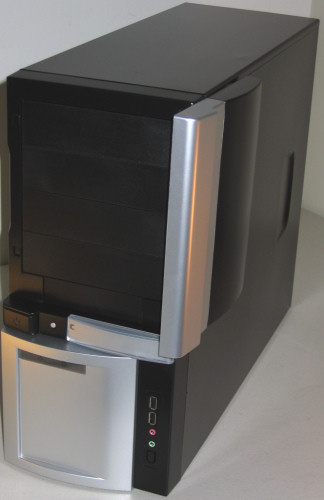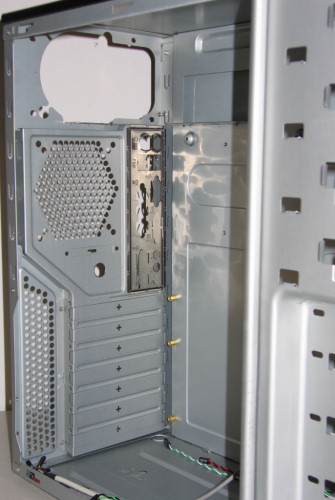Price-Point Comparing Three-Way Case Shootout
by Joshua Buss on January 13, 2006 12:05 AM EST- Posted in
- Cases/Cooling/PSUs
Dynapower E68 (cont’d)
The bezel doesn't just have the ability to slide at the bottom either; in addition to hinging to reveal the drive bays, the main portion (the top door) also slides along a couple of slits so that after opening, it can be further moved out of the way. While some people might consider such a dynamic front gaudy, it's still undeniable that it's a very nice front panel, especially given this unit's cost.
With all the attention that the front of this case has received, it's a good thing that the rest of the case is almost entirely devoid of anything that needs a lengthy explanation! This last picture of purely the exterior of the chassis really doesn't differ much from the other two cases that we've looked at all. Again, the side-mounted 120mm fan shows up, but besides that, there are no other elements of cooling to investigate here.
With that investigation over, let's dive into this value-oriented case. First off, as is probably to be expected, there are no tool-less elements in the E68. Also, we should mention that we actually routed the cables from the front through a different opening to help our cable management.
Even so, the actual expandability of the Dynapower case is just as good as the other two cases. Four hard drives, one external 3½“, and four external 5¼” drives can all be accommodated in the E68.
Support for different motherboard types is even more limited in this case, but again, the standard ATX types shouldn't be much of a problem, if at all.
Standard knock-out expansion card covers are the name of the game here, but unlike other incarnations, these won't sever an appendage when attempting to remove them. And considering the lack of tool-less options here, it's tough to beat the tried-and-true method of using a single screw to hold each add-in card in place.
Really, that's about all there is to the inside of the E68. With a steel construction, the case feels just as sturdy as the X1, and if one wants, they can add another 120mm fan in the back and 80mm in the front. Installing our test bed was entirely void of surprises. The side-mounted IDE cable was neither easier nor harder than in the previous mid-towers.
The bezel doesn't just have the ability to slide at the bottom either; in addition to hinging to reveal the drive bays, the main portion (the top door) also slides along a couple of slits so that after opening, it can be further moved out of the way. While some people might consider such a dynamic front gaudy, it's still undeniable that it's a very nice front panel, especially given this unit's cost.
With all the attention that the front of this case has received, it's a good thing that the rest of the case is almost entirely devoid of anything that needs a lengthy explanation! This last picture of purely the exterior of the chassis really doesn't differ much from the other two cases that we've looked at all. Again, the side-mounted 120mm fan shows up, but besides that, there are no other elements of cooling to investigate here.
With that investigation over, let's dive into this value-oriented case. First off, as is probably to be expected, there are no tool-less elements in the E68. Also, we should mention that we actually routed the cables from the front through a different opening to help our cable management.
Even so, the actual expandability of the Dynapower case is just as good as the other two cases. Four hard drives, one external 3½“, and four external 5¼” drives can all be accommodated in the E68.
Support for different motherboard types is even more limited in this case, but again, the standard ATX types shouldn't be much of a problem, if at all.
Standard knock-out expansion card covers are the name of the game here, but unlike other incarnations, these won't sever an appendage when attempting to remove them. And considering the lack of tool-less options here, it's tough to beat the tried-and-true method of using a single screw to hold each add-in card in place.
Really, that's about all there is to the inside of the E68. With a steel construction, the case feels just as sturdy as the X1, and if one wants, they can add another 120mm fan in the back and 80mm in the front. Installing our test bed was entirely void of surprises. The side-mounted IDE cable was neither easier nor harder than in the previous mid-towers.
















69 Comments
View All Comments
Tamale - Friday, January 13, 2006 - link
You know, several of those descriptions never did sit well with me.. and perhaps I am a little too biased towards the geekier look... I'll try to tone down my enthusiasm for the X1 a bit.As for the hard mounting vs. soft mounting, our maxtor IDE drive is very very quiet, and seeking noises couldn't be heard in the P150 at all even using the "hard" (silicone grommets) mount.
Seeking sounds were only barely audible in the E68 and X1.
strikermlc - Friday, January 13, 2006 - link
I'm sorry, but the statement about the p150 falling short because it doesn't even have a "classy window" on the side is incredibly funny to me. Personally the p150 is the only one out of the three cases that would aesthetically have a chance of making it into an open living space in my home. I'm just as big of a gamer and hardware geek as anyone and I've been a daily reader of anandtech for years - but that comment in my opinion clearly reinforces that while anandtech should be held in very high regard for their knowledge of hardware - their aesthetic evaluations are clearly lacking.While the front of the raidmax case is not unforgivable - the side panel is. The window is downright tacky and the decorative arrows around the window are laughable - as if the window that will soon be displaying countless oversized glowing fans and other lights is incapable of attracting enough attention on it's own?
I realize everyone is entitled to their own opinion. And while I'm sure there are plenty of twelve year old anandtech readers drooling over this case, the window on this case is in no means and under no circumstances "classy" and it never will be. There have got to be plenty of adult readers at anandtech that will agree with me on this point.
True class is understated - and that's what I want my case to exhibit. Well designed functionality, quiet, crisp clean lines and quality materials - brushed metal and glossy paint are certainly fine, it doesn't have to be boring by any means. It just shouldn't fill the room with a whirling, glowing, fire-eating circus show.
Ah well, I've made my point. $0.02 from a graphic designer that loves his pc's and computer hardware just as much as the next anandtech reader, and unlike most graphic designers, regard's mac's as simply an overpriced novelty item.
Thanks and good night.
aaron
yacoub - Friday, January 13, 2006 - link
Well stated, aaron. The P150 is the most mature looking of the three cases - the most gimmick-free. Everything about it is functional and meant to meet its design goals of the best quiet-computing mid-tower on the market. It succeeds.Erssa - Friday, January 13, 2006 - link
I cannot believe that the amateur reviewer hardmounted the HDD instead of using the soft mount method, that would have subjectively really made a difference in sound levels.Very superficial review overall. I wonder what the reviewer would have said about the cases had he used a silent cpu cooler (even zalman 7700cu fan mated would have been good) and passive GPU. I believe it would have really turned out the table for antecs advantage. Sound measurements from the sides would have been a nice addition aswell. Since antec was the only case that had no ways for sound to escape from the side. Measuring noise from 6" doens't make too much sense either since nobody has his head 6" from the front of his computer. Something like 1m would have been nice, but that would have probably ment that combined with more silent combonents the sound measuring device would have proved itself inadequate.
Xenoterranos - Friday, January 13, 2006 - link
That wouldn't have really been a case test then would it? It would have been a silent-cpu-cooler-and-passive-gpu-cooler-in-cases-x-y-and-z test.While I can't disagree on the technical merrits of the Raidmax case, those little blue triangles really turn me off. Maybe I'm just not aesthetically inclined.
Trippytiger - Friday, January 13, 2006 - link
The Antec may be the most expensive of the group, but it seems to me that it also comes with the most trustworthy power supply of the three as well. I know I'd want to replace the power supply in that Raidmax case if I were going to use it.Tamale - Friday, January 13, 2006 - link
You can get it without one entirely if you want for only $50. Also, heed my note about the Raidmax supply - it's been running strong (and still is by the way) in another decently-equipped PC here in my lab.mindless1 - Friday, January 13, 2006 - link
It's been running, but what is "strong"? That it runs? The question with such PSU is not does it run but how long it does and what happens when it begins failing. If it does not last the life of the system, another PSU must be bought and all savings are negated.Tamale - Saturday, January 14, 2006 - link
By strong I simply mean steady voltages, even under load. And of course, length of life is an issue, but I've only had the power supplies for a few weeks, so I comment on that much, other than the fact that both Antec supplies I received have problems with the 3.3v rail.leofischer - Friday, January 13, 2006 - link
I doubt the drives were suspended, because he says'Also note the rubber bands stretched across the sides of this cavity. While we're not 100% sure, we are fairly certain that this is an effort to help minimize vibrations from the hard drives that may cause additional noise within the case.'
duh..
Doesn't seem like he realised what the bands were for. I assume there is some kind of explanation accompanying the case or mention of the suspension method in literature, but I wouldn't know.